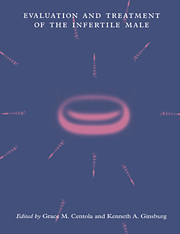Book contents
- Frontmatter
- Contents
- Preface
- List of contributors
- 1 Andrology
- 2 Sperm–egg interaction
- 3 Routine semen analysis
- 4 Computer-aided sperm analysis: a critical review
- 5 Antisperm antibodies: diagnosis and treatment
- 6 The sperm penetration assay
- 7 Intrauterine insemination for male factor
- 8 Processing human semen for insemination: comparison of methods
- 9 New assays for evaluating sperm function
- 10 Assisted reproductive technology for male factor infertility
- 11 Microinjection techniques for male infertility
- 12 Therapeutic donor insemination: screening, indications and technique
- 13 Endocrine assessment and hormone treatment of the infertile male
- 14 The urologic evaluation of the infertile male
- 15 Azoospermia: the diagnosis and treatment
- 16 White blood cells in semen and their impact on fertility
- 17 Psychological aspects of male infertility: lifting the shroud of shame
- 18 Evaluation of the female partner
- Index
6 - The sperm penetration assay
Published online by Cambridge University Press: 16 September 2009
- Frontmatter
- Contents
- Preface
- List of contributors
- 1 Andrology
- 2 Sperm–egg interaction
- 3 Routine semen analysis
- 4 Computer-aided sperm analysis: a critical review
- 5 Antisperm antibodies: diagnosis and treatment
- 6 The sperm penetration assay
- 7 Intrauterine insemination for male factor
- 8 Processing human semen for insemination: comparison of methods
- 9 New assays for evaluating sperm function
- 10 Assisted reproductive technology for male factor infertility
- 11 Microinjection techniques for male infertility
- 12 Therapeutic donor insemination: screening, indications and technique
- 13 Endocrine assessment and hormone treatment of the infertile male
- 14 The urologic evaluation of the infertile male
- 15 Azoospermia: the diagnosis and treatment
- 16 White blood cells in semen and their impact on fertility
- 17 Psychological aspects of male infertility: lifting the shroud of shame
- 18 Evaluation of the female partner
- Index
Summary
Introduction
Since spermatozoa were first observed in the human ejaculate by Leeuwenhoek in the late seventeenth century, it has been believed that a threshold number of motile and morphologically normal spermatozoa is required to initiate a pregnancy. More recently it has been determined that the functional competence of these sperm is somewhat poorly reflected by the conventional semen analysis. Therefore, much work has been done to develop functional tests which may more accurately reflect fertility status. The sperm penetration assay (SPA) or zona-free hamster egg test is one such test which is designed to evaluate sperm functional competence or fertilizing potential. It is based on the phenomenon that a hamster egg, when rendered zona-free by proteolytic digestion of the zona pellucida, can be penetrated by spermatozoa from another species, such as the human. The cross-species ‘fertilization’ assay is correlated with true fertility and thus has diagnostic potential in human fertility problems. Much has been written about this assay since the presentation of our first human–hamster experiments in 1976 (Yanagimachi et al., 1976). The purpose of this chapter is to focus on a few aspects of the assay, including a brief review of SPA methodology, comparison of the SPA with other semen tests, validity of the SPA in prediction of in vivo pregnancy, and predictive potential of the SPA for the success of in vitro fertilization (IVF).
SPA methodology
The original SPA methodology (Yanagimachi et al., 1976) used washed sperm preincubated in BWW (Biggers, Whitten and Whittinghams's medium) for 2–7 hours.
- Type
- Chapter
- Information
- Evaluation and Treatment of the Infertile Male , pp. 58 - 71Publisher: Cambridge University PressPrint publication year: 1996



